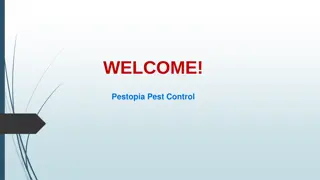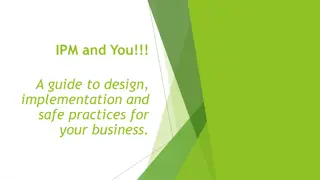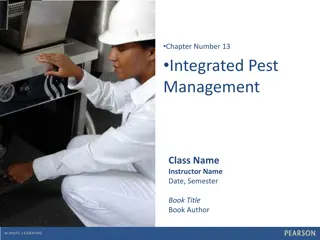Pest Management Regulatory Approaches for Lakes Water Quality Workshop
Explore the regulatory framework for pest management in lakes, highlighting the role of councils, statutory and non-statutory plans, regional pest management strategies, and pest control programs. Discover key elements such as biosecurity objectives, statutory requirements, and the importance of collaboration in effective pest management.
Uploaded on Oct 09, 2024 | 0 Views
Download Presentation

Please find below an Image/Link to download the presentation.
The content on the website is provided AS IS for your information and personal use only. It may not be sold, licensed, or shared on other websites without obtaining consent from the author. Download presentation by click this link. If you encounter any issues during the download, it is possible that the publisher has removed the file from their server.
E N D
Presentation Transcript
Regulatory approaches for pest management Lakes Water Quality Workshop 27 September 2018
Councils Biosecurity objectives and aspirations Council has a leadership role in pest management for the region Prevent pests entering and establishing in the region Manage pests when it is practical and cost effective. Support landowners and communities to manage pests and prevent spread. Work in partnership with other parties that have pest management responsibilities
Plans are just one of the tools available. Information Statutory Plans Awareness Engagement Incentives Regulations Non-Statutory plans
Non-Statutory vs Statutory plans Bay of Plenty Regional Pest Management Plan Strategy for the Lakes of the Rotorua district Bay of Plenty Natural Resources Plan Draft Aquatic plant management plans Long Term Plan
Regulatory framework Biosecurity Act Unwanted Organisms , Pest Management Plans, Pathway Management Plans, Small-scale Management Programmes Resource Management Act Biodiversity, regional policy statements and plans, consents Local Government Act Community outcomes, consultation requirements, funding (via LTP)
Regional Pest Management Plan Developed under the Biosecurity Act Must comply with the National Policy Direction Pest programmes & objectives Cost benefit assessments Outcome must be achievable Funding to deliver must be available Set out roles, responsibilities, principal measures & rules
RPMP Pest programmes Exclusion - Keep it out Eradication - We get rid of it Progressive Containment - We stop the spread and push it back over time Sustained control - manage impacts Site-led - We protect values of a specific site
Current RPMP vs Proposed RPMP Pest animals Current RPMP Programme Proposed RPMP Programme Catfish Exclusion Exclusion, progressive containment Koi carp Eradication Eradication Perch Exclusion Eradication Tench & Rudd Containment Progressive containment
Current RPMP vs Proposed RPMP Pest Plants Current RPMP Programme Proposed RPMP Programme Egeria Containment Exclusion, progressive containment Elodea Restricted Exclusion, sustained control Hornwort Containment Exclusion, eradication, progressive containment Hydrilla Agency National Interest Pest Response - MPI Lagarosiphon Containment Exclusion, progressive containment Sagaittaria New incursion Eradication Salvina Agency National Interest Pest Response - MPI Water hyacinth Agency National Interest Pest Response - MPI Water poppy Eradication Exclusion
Proposed RPMP rules Rule 6 For all pests listed in the exclusion, eradication, progressive containment or sustained control programmes: 2) No person shall move, or allow to be moved, any live pest listed in this RPMP, or any machinery, vessel, organism or goods that are contaminated with any pest listed in this RPMP, and 3) No person shall keep, plant, propagate, distribute or release any pest listed in this RPMP or assist in their maintenance including tending, feeding or sheltering them.
Proposed RPMP rules Rule 7 To avoid the spread of aquatic pests, the following provisions apply: 1) No person shall leave boat trailers in any water body other than for the purposes of launching and/or retrieving boats. 2) No person shall transport ballast water from any water body to any other location. 3) All owners of vessels or craft entering any water body within the Bay of Plenty shall ensure their vessels or craft (including trailers) are free from freshwater pest fish and lake weed including fragments.
Please make a submission! Go to: https://www.boprc.govt.nz/our-region-and-environment/pest- management/proposed-regional-pest-management-plan/ Please contact Greg or Lisa if you wish to meet with staff to discuss the Proposed RPMP: Greg.corbett@boprc.govt.nz Lisa.power@boprc.govt.nz























